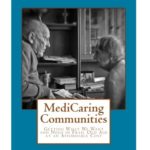
By Joanne Lynn
Nearly all Americans want a long life, and many of us will live into our 80’s and beyond. But as a society, we have avoided addressing the challenges of living well in the last years at a cost that our families and taxpayers can sustain. That’s about to change.
A new MediCaring Communities book from the Center for Elder Care and Advanced Illness, authored by Dr. Joanne Lynn, provides a comprehensive blueprint for re-engineering — in highly practical, doable terms — how to better organize service delivery and current publicly financed programs so that all Americans can count on living comfortably and meaningfully through the end of life. MediCaring Communities are deliberately designed to customize care around the priorities of elders and their families. The model also offers local organizations and governments a financial lifeline and a way to share in managing a care system so that it is as reliable and efficient as possible.
The MediCaring Communities model takes the best of “lessons learned” and “best practices” from the public literature and on-the-ground experience gained from working with frail elders and across many services systems. It addresses the unique needs of elders who need both medical care and long-term care through organizations that are either adapted or established de novo in order to deliver tailored geriatric and supportive services. These services are in turn modulated by each elder’s care plan – defined as a record of services that comport with an individual’s treatment preferences and quality of life goals. The substantial Medicare savings that result from lower utilization of high-cost services and improved, appropriate geriatric care, are then repurposed and reinvested in vital and underfunded homecare and related social supports, including home delivered meals, transportation, and training and respite for family caregivers.
Virtually everyone agrees this type of care is what they want for themselves and for their loved ones. We know exactly where we need to go, but how do we get there?
PACE Expansion
The Program of All-Inclusive care for the Elderly (PACE) provides one opportunity. PACE already has a solid reputation as a comprehensive program primarily for dually eligible beneficiaries who need medical care and long-term services and supports (LTSS). With the November 2015 passage of the PACE Innovation Act (P.L. 114-85), which brought innovations with PACE under the authority of the Center for Medicare and Medicaid Innovation (CMMI), the federal government now has streamlined authority to fund innovations in the PACE model. With a green light from CMMI, PACE programs will be able to test expansions in two key populations: (1) Medicare beneficiaries or “pre duals,” who need LTSS services, and (2) dually eligible beneficiaries who are not yet disabled enough to meet their state’s Medicaid definition of a nursing home level of care.
If PACE scales to take on these new populations, the program’s advisory board could readily evolve to become independent and reflect a broader community perspective on frail elders. In so doing, it could take on greater responsibility for monitoring and improving eldercare services across the community. Such PACE expansion programs could show how to anchor a comprehensive model of care for all similarly situated frail elders in the area, whether or not they are disabled enough to qualify for a Medicaid nursing home level of care.
ACOs and MCOs
Another mainstream Medicare model is an Accountable Care Organization or a managed care plan. Either could sponsor a MediCaring Community by accounting for frail elders in a defined geographic area separately from their overall business, and establishing an integrated clinical and LTSS delivery system in that community. The savings harvested from avoiding low-value, overutilized services would be calculated annually. A share would go to Medicare, but most would be retained for reinvestment in social and supportive services. Challenges associated with an adapted ACO model are that the usual ACO has little track record to build upon for constructing an independent board and for collaboration with LTSS providers, but other organizations in their communities would likely have strengths in these areas and be willing to collaborate. ACOs also have substantial barriers to establishing dominance in an area and their current quality metrics are not well matched to service needs of frail elders, so both of these would need work to overcome. ACOs also often have limited expertise in geriatric care, and would need coaching to build strong interdisciplinary teams quickly.
MCOs likewise could sponsor a MediCaring Community, in much the same way as ACOs. An MCO would collect per member per month premiums, and savings would be the profits in hand. The challenges in developing clinical expertise, care plans, connections with LTSS providers, and an independent board would be fairly similar to the ACO issues outlined above. MCOs also face the challenge of today’s “star rating” system for quality. Excellent frail elder care effectively means not complying with many standard quality metrics, including tight control of diabetes, hypertension, and screenings for cancer. Also, MCOs are now required to offer the same package to all beneficiaries, so an MCO could not offer a MediCaring Community package in one area and not in others without a federal waiver.
There are several potential paths forward, but much work will be needed to get there. However, there are steps you can take today to get America moving in the right direction. You can push your Congressional representatives and state officials to allow MediCaring Communities to proceed, and encourage consumer and professional organizations to get involved. Lastly, spread the word about the MediCaring Communities book — Read it, and write a review on Amazon! We also welcome your thoughts and feedback. Write us at [email protected] with suggestions for improvement.
